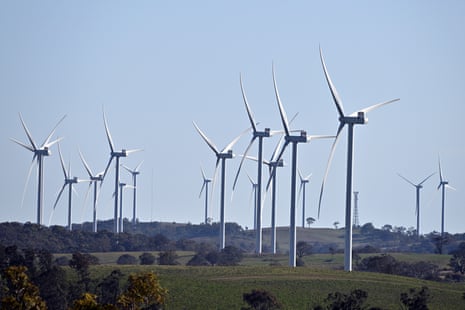Industry super funds have warned the Albanese government that Australia’s energy transition risks falling behind as big funds chase more compelling investment opportunities in the US, UK and Europe.
AustralianSuper, cbus, HostPlus, CareSuper, HESTA and UniSuper have co-authored a new report with Australian fund IFM Investors calling for more favourable investment conditions underwritten by taxpayers to unlock private capital for the domestic transition to net zero emissions.
Ahead of a roundtable on climate finance with the treasurer, Jim Chalmers, on Monday, the funds argue that $12bn a year on average between now and 2050 will be required to transition to renewable energy in Australia and a further $40bn a year to build new export industries and decarbonise the rest of the economy.
The independent Climate Change Authority warned this week that Australia risks falling short of its 2030 climate target, and time was running out for it to make a prosperous transition to net zero emissions on its own terms.
The new report from industry super says “capital is flowing to places with more attractive investment opportunities, strong climate and energy policies and growing demand for clean energy and low-carbon goods and services”.
The funds note the Biden administration’s Inflation Reduction Act has seen eight years’ worth of clean energy investment worth more than US$270bn (A$406bn) pulled in to the United States. “Australia can’t afford to be left behind,” the new report says.
IFM Investors confirmed earlier this week it will sink £10bn (A$19bn) into infrastructure and energy transition projects in the UK by 2027 as part of a new memorandum of understanding with the Sunak government.
The warning from the funds – directed at the commonwealth and the states – has been echoed by the Australian Energy Market Operator and the Clean Energy Council.
Industry super funds manage about $1.2tn and are expected to more than double in size to about $3tn by 2030. The funds are calling on the government to fast-track planning approvals for transmission infrastructure while making domestic investment opportunities more competitive to help keep clean energy capital in the country.
The new report argues that distribution network service providers – the organisations that own grid hardware, like power poles, cables and substations – should be allowed to provide greenfield transmission projects if they have the “right delivery, safety and workforce record”. At the moment, transmission network providers have exclusive access to potential greenfield projects.
It calls for a national plan for the rollout of transmission infrastructure. The elements should include streamlined approvals, early consultation with affected communities, fair compensation for landholders, new opportunities for local communities to benefit from the infrastructure and a skills development agenda.
Noting that the cost of building new transmission is ultimately passed on to energy users, the funds say that impact can be reduced through concessional finance or “availability payments” – a form of public-private partnership – for new projects.
after newsletter promotion
The funds welcome the Albanese government’s recent decision to radically expand a taxpayer-underwritten scheme to support new clean power generation and storage capacity. But they say extending the capacity investment scheme should be completed by power purchase agreements “to provide long-term stable revenue streams for renewable electricity”.
Aviation is considered to be a hard-to-abate sector because it is emissions-intensive and the cost of reducing emissions is high. The funds say the government could accelerate the development of a sustainable Australian aviation fuel industry with a production tax credit, a new certification scheme and the market allowing credits to be recognised and traded.
To drive the decarbonisation of the economy, the funds say the national net zero roadmap, now under development, requires plans for emissions reduction objectives for specific industry sectors, backed by a policy framework developed with the investor community.
“Governments’ efforts to make Australia a renewable energy superpower should be ambitious about the scale of opportunity and proportionate to the imperative to ensure Australia can lead in the global competition for capital,” the report says.
“Policy and investment support for new and emerging net zero industries, including advanced manufacturing of generation and storage technologies, refining and processing critical minerals, renewable hydrogen and green metals like green iron, steel and aluminium will help grow a pipeline of investment opportunities and grow demand for low-carbon good and services.”
After expanding the capacity mechanism to help meet the objective of Australia running on 82% renewable energy by 2030, the government this week has also settled the investment mandate of the National Reconstruction Fund. The prime minister, Anthony Albanese, characterised this fund as “money in the bank, ready to invest in new jobs, new skills, new technologies and new industries”.
The climate change minister, Chris Bowen, hopes to expand the government’s $2bn Hydrogen Headstart program and apply that same model to other industries, as part of a specific response to the challenges posed by Joe Biden’s Inflation Reduction Act.
